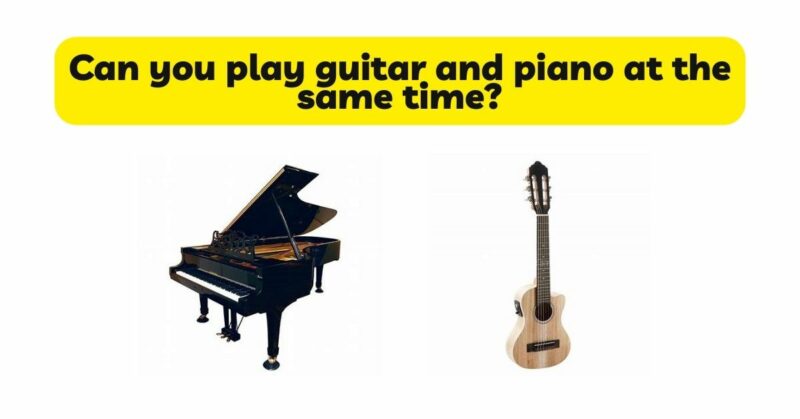The world of music is filled with endless possibilities for creativity and innovation. As musicians seek to expand their horizons, the question arises: Can one play guitar and piano at the same time? While traditionally considered separate instruments, talented individuals have demonstrated the ability to combine the sounds of both guitar and piano in their performances. In this article, we will explore the concept of playing guitar and piano simultaneously, discussing the techniques, challenges, and potential advantages of merging these two beloved instruments. By understanding the technical aspects, coordination requirements, and musical possibilities, we can uncover the realm of playing guitar and piano together.
- The Concept of Simultaneous Playing: Simultaneously playing guitar and piano involves the art of coordinating the techniques and sounds of both instruments in real-time. This unique approach allows musicians to blend the melodic qualities of the guitar with the harmonic richness of the piano, creating a layered and textured musical experience. While challenging, the rewards are plentiful for those who master this skill, as it offers expanded creative possibilities and a distinct musical identity.
- Technical Considerations: Playing guitar and piano simultaneously requires a solid foundation in the techniques of both instruments. Guitarists must possess proficiency in chords, fingerpicking, strumming, and fretting, while pianists need a strong understanding of scales, chords, hand coordination, and playing dynamics. Becoming well-versed in the technical aspects of each instrument is essential before attempting to combine them effectively.
- Hand Independence and Coordination: Hand independence and coordination are paramount in the pursuit of playing guitar and piano simultaneously. Each hand must operate independently, executing different musical parts concurrently. This demands focused practice to develop the ability to play distinct melodies, chords, or rhythmic patterns simultaneously. Exercises that isolate each hand’s movements and gradually integrate them can significantly aid in achieving the required level of coordination.
- Determining Roles and Musical Elements: To successfully play guitar and piano together, it is crucial to determine the roles and musical elements each instrument will contribute. Consider whether the guitar will take on a melodic or rhythmic role, while the piano provides harmonic accompaniment. Explore how these roles can interchange or merge throughout a performance, allowing for dynamic musical expressions and textures. Determining the specific contributions of each instrument allows for intentional and cohesive musical arrangements.
- Integration of Chords and Melodies: The integration of chords and melodies is a fundamental aspect of playing guitar and piano simultaneously. As the guitar strums chords, the piano can provide melodic embellishments or harmonize with the guitar’s melody. Conversely, the piano can play chord progressions while the guitar performs intricate melodies or solos. Finding the right balance and synchronization between the guitar and piano is key to achieving a cohesive and harmonious sound.
- Technique Adaptation: Adapting playing techniques to accommodate both instruments is essential when combining guitar and piano. Guitarists must explore fingerpicking patterns that allow for fluidity and control while coordinating with piano playing. Adapting strumming techniques to facilitate rhythmic accompaniment is also crucial. Pianists should focus on maintaining smooth hand movements and finger positioning while coordinating with guitar playing. This may involve adapting fingerings and exploring different voicings to optimize hand coordination and achieve a balanced sound.
- Coordination of Timing and Rhythm: Achieving coordination in timing and rhythm is vital when playing guitar and piano simultaneously. Both instruments must align rhythmically to maintain a cohesive musical performance. Developing a strong internal sense of timing and practicing with a metronome or accompanying tracks can help solidify rhythmical precision. Attentiveness to rhythmic subdivisions, syncopation, and maintaining a steady tempo is essential. By honing these skills, musicians can seamlessly coordinate the timing and rhythm between guitar and piano.
- Creative Expression and Musical Exploration: Playing guitar and piano simultaneously provides an avenue for unparalleled creative expression and musical exploration. Musicians can experiment with various musical styles, genres, and textures by combining the unique tonal qualities of both instruments. This fusion opens doors to improvisation, allowing for spontaneous interactions between the guitar and piano. Embracing the freedom to create one’s own musical arrangements and interpretations is key to unleashing the full potential of playing guitar and piano simultaneously.
Conclusion: In conclusion, the possibility of playing guitar and piano simultaneously exists for talented and dedicated musicians. While it requires technical proficiency, hand independence, and coordination, the rewards are plentiful. By merging the melodic qualities of the guitar with the harmonic richness of the piano, musicians can create captivating and layered musical performances. The journey towards mastering this skill involves understanding the technical aspects, coordinating timing and rhythm, and exploring creative expression. Through intentional practice, experimentation, and a passion for both instruments, musicians can unlock a world of unique musical possibilities. Playing guitar and piano simultaneously represents a multifaceted artistic expression that brings together the best of both worlds, delighting audiences and elevating the musical experience to new heights.


